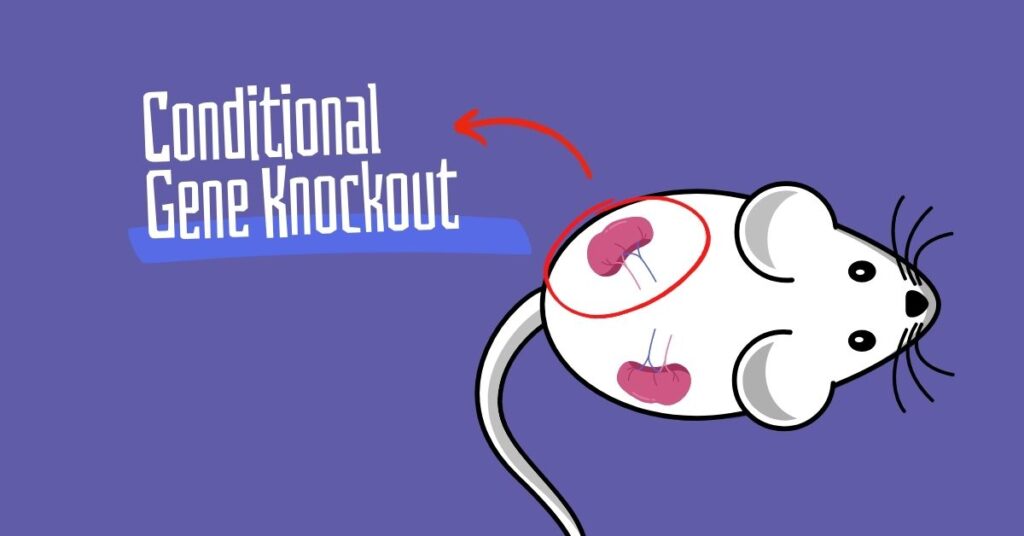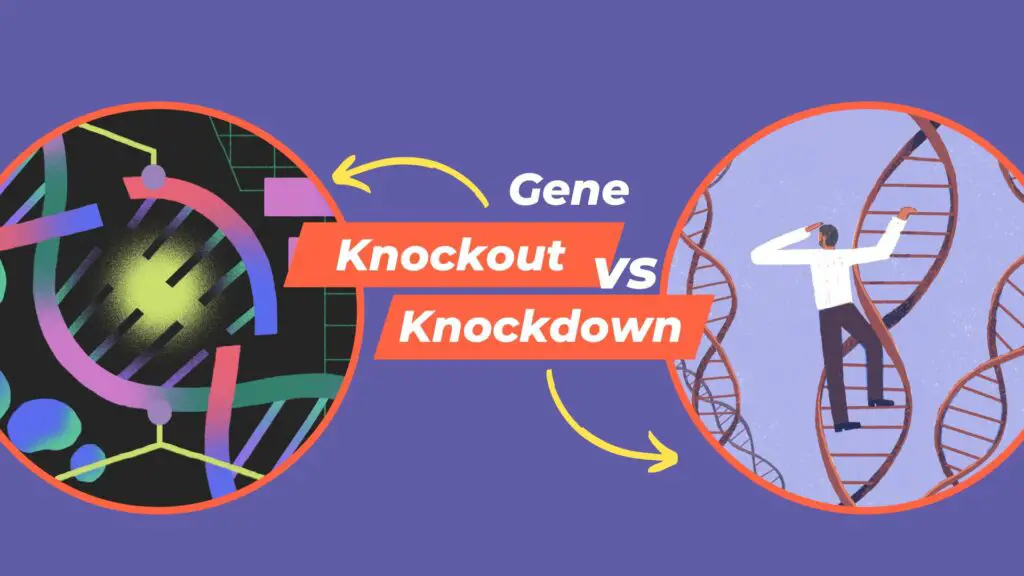“Conditional knockout is a cell, tissue or organ-specific gene knockout. In this article, learn about conditional knockout, its importance, applications, advantages and limitations.”
In the previous articles of this series, we have discussed the general idea of gene knockout including a brief overview of the process and how to construct knockout mice. In one more article, we have discussed the differences between gene knockout vs gene knockdown.
Here, we will go one step ahead in the topic and learn conditional knockout.
Conventional gene knockout techniques can inactive a gene. And scientists can study the effect of the action. But what if we wish to study the effect of a gene on a specific cell type, tissue or organ?
What if we want to study how some genes can regulate tissue or organ-specific activities? Here, comes the role of conditional gene knockout, where scientists give an additional ‘condition’ in the process– cell, tissue or organ-specific knockout.
In this article, we will explore the concept of cKO (Conditional gene knockout), its applications, limitations and why it’s important in genetic research. We will also look into some of the systems used.

Stay tuned.
Key Topics:
What is Conditional Gene knockout?
Gene knockout is a technique to selectively inactive a gene. In the previous article, we discussed the concept, steps, methods and applications of gene knockout. You can read it first to learn the fundamental concepts.
Put simply, in the gene knockout process, a mutation or sequence is incorporated using a vector-mediated approach to make a gene silent entirely. However, this approach is random and may cause the death of the organism by side effects of gene inactivation.
In addition, the full effect of the gene for a particular action or tissue can not be studied, as a gene may have a role in many other biological activities. So to overcome these limitations, a technique known as conditional gene knockout is developed.
Here the effect of a gene can be studied in a controlled manner. Instead of knocking out a gene from all the cells, temporal inactivation in a specific cell type, tissue, organ or developmental stage offers more advantages in the study.
The idea originally came into the light during the 90s when scientists looked to study a gene’s function in a more precise way and wanted to overcome the runaway effect of the conventional KO.
During the 1980s, Sternberg L discovered the recombinase ‘Cre’ and associated loci (Lox) but was used by Sauer B for mammalian gene knockout. Notedly, the Cre-lox system was adopted for the conditional knockout by Gu et al. (1995) to construct a tissue-specific gene knockout mice.
For instance, suppose scientists want to know the effect of the APOL1 gene on kidney function. APOL1 is a component of the innate immune system. Now what scientists do, they selectively only deactivate the APOL1 gene from the kidney cells or tissue.
Scientists can understand how the inactivation of APOL1 in only kidney cells contributes to kidney dysfunction. Widely known cKO systems like Cre-LoxP, Dre-Rox and FLP-FRT can be used for such studies. We will explain each system in the upcoming section.
Now, to understand the concept of conditional knockout more effectively, we have to understand the differences between conventional and conditional knockout.
Conventional vs conditional knockout:

Conventional KO is a general gene knockout process which is also known as constitutive gene knockout. The conditional KO is a specific process of gene knockout which is also known as tissue-specific KO.
In constitutive KO, the knockout affects a gene from all the cells of an organism while conditional KO affects a gene from only the specific tissue or organ.
The expression of constitutive knockout can be permanent and remains for all the time while the expression of conditional knockout can be temporary and occurs at a specific time.
Thus, conventional/constitutional KO shows more side effects while tissue-specific conditional gene KO has fewer side effects.
In addition, as the constitutional knockout occurs randomly for all cells, it isn’t adequately accurate while the conditional knockout is more accurate.
The results of constitutive KO affect the whole organism, the target may die with the effect being more lethal. While conditional KO affects only the tissue or organ being studied and thus is safer.
Furthermore, the effect of a target gene can’t be studied at a specific developmental stage in constitutive KO while the effect of a target gene can be studied more accurately at a specific developmental stage in conditional KO.
These are the reason, the conditional KO is widely used in research but not the constitutive KO.
Some of the popular techniques used for constitutive KO are TALEN, CRISPR-CAS9, RNA interference, etc while some of the techniques used for conditional KO are Cre-LoxP, Dre-Rox and FLP-FRT.
Now this makes the concept clear on conditional knockout!
Conditional knockout systems:
Conditional knockout high relies on tissue-specific recombination and uses a recombinase and target gene-specific flanking region for the experiment. Some of the well-studied and popular cKO systems including Cre-LoxP, Dre-Rox, FLP-FRT and others used to construct knockout mice are discussed in this section.
Cre-LoxP system:
In mice and other mammalian model organisms, the Cre-lox system is popularly used. Here, ‘Cre’ is a recombinase enzyme that can determine the Lox DNA sequence present in the gene.
Using a tissue-specific promoter, LoxP flanking sequences, the homologous recombination achieves tissue-specific gene knockout. As aforementioned, Sternberg L (1980) discovered the recombinase ‘Cre’ and Lox sequence.
Dre-Rox system:
Much like the Cre-Lox, in the Dre-Rox system, ‘Dre’ is the recombinase enzyme that recognizes the Rox sequence and performs tissue-specific recombination. However, it can only perform KO only if it finds two separate ‘rox’ sites oriented in the same direction.
FLP-FRT system:
Yet another common cKO system used by scientists is FLP-FRT in which ‘FLP’ is a recombinase while ‘FRP (Flippase Recognition Target)’ is a DNA sequence to be recognized by the FLP.
Through the crossing over between FRT-flanked gene mice and FLP-recombinase mice, scientists can inactivate a target gene by a deletion in a specific tissue or at a specific developmental stage.
Tet-On/Tet-Off system:
Tel-On/Tel-Off is yet another common conditional gene knockout system used in gene expression studies. Research can On or Off gene expression in the particular tissue using tetracycline-controlled transcriptional activity.
CRISPR-CAS9:
The futuristic and most popular tissue-specific gene knockout approach is CRISPR-CAS9. It’s a revolutionary gene editing technique that uses three components- CRISPR, CAS9 protein and guided RNA.
The guided RNA guides the CAS9 protein to find its target location through the CRISPR element and perform gene edition. CRISPR systems can effectively perform tissue-specific cKO.
To know more, read this article: Step-by-step Process of CRISPR CAS9.
Summary of various cKO systems:
| cKO system | Recombinase enzyme | Target-sequence | Tissue-specificity |
| Cre-Lox | Cre | LoxP | Yes |
| Dre-Rox | Dre | Rox | Yes |
| FLP-FRT | FLP | FRT | Yes |
| Tel-On/Tel-Off | Tel | tetO (tetracycline-operator sequence | Yes |
| CRISPR-CAS9 | Cas9 | Guided RNA | Yes |
Importance of Conditional knockout:
Conditional knockout allows scientists to study a gene’s expression accurately, and precisely, with fewer side effects, and in specific cells, tissue or organ or developmental stage. Here are some of the applications of cKO.
Applications:
Tissue-specific studies:
cKO has primer application in tissue-specific studies, where researchers deactivate a gene in a particular tissue to understand its function and importance in that particular tissue. Such studies help determine and study physiological activities governed by a target gene in a specific tissue.
It can also be helpful, in this way, to determine how lethal or not a gene’s inactivation is for a tissue. It gives us more power to keenly understand the function and biological significance of a gene.
Developmental studies:
cKO is an amazing tool for developmental studies and understanding the significance of a gene or set of genes for various developmental stages and activities.
To strengthen the present intervention, gene inactivation can be controlled for a specific developmental stage, for a specific tissue and for a specific time. This gives us more valuable information regarding the developmental stage and overall embryogenesis.
Disease modeling and studies:
Yet another important application of cKO is in disease modeling and studies. The effect of disease and related gene(s) and their implications on a particular tissue type, a set of tissues or organs can be extensively studied.
This allows researchers to study disease molecular mechanisms, and potential therapeutic targets, thereby helping in testing and treatments.
Besides these three key applications, cKO is often used in functional genomic studies, pharmacogenomics, antibiotic research, drug modeling, targeting and discovery, behavioral studies and other genetic studies.
Advantages:
- It can determine gene activity at the cells, tissue or organ level.
- It is more accurate than other knockout techniques.
- It is safer with a fever death rate.
- It is less complex than the constitutional KO.
- It has fewer embryonic lethality and developmental complications.
- It can study gene function in adult organisms as well and helps study a disease from any developmental stage.
Limitations:
Conditional KO is a popular knockout choice among scientists, however, has certain limitations as well.
- The major limitation of the cKO is achieving complete tissue-specific gene knockout. Such a technique, can not, sometimes, inactive a gene entirely and cause misinterpretation.
- cKO also shows an off-targeting effect as well.
- High-end instrumentation setup, expertise and experience are required to design, execute and perform these kinds of experiments and to achieve success.
Wrapping up:
Gene knockout is a fantastic tool for studying gene function. But there’s an even better and more flexible version is ‘conditional knockout.’ Scientists use tissue-specific knockout systems in mice to explore different genes and their functions.
However, there are challenges like off-target effects and unintended outcomes that need to be addressed. In conclusion, a conditional knockout is a great way to study genes without compromising the organism.
We hope you enjoy this article. Share it and check out our other articles in this series.
Sources:
Yarmolinsky, Michael, and Ronald Hoess. “The Legacy of Nat Sternberg: The Genesis of Cre-lox Technology.” Annual review of virology vol. 2,1 (2015): 25-40. doi:10.1146/annurev-virology-100114-054930.
Subscribe to our weekly newsletter for the latest blogs, articles and updates, and never miss the latest product or an exclusive offer.



